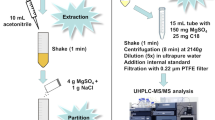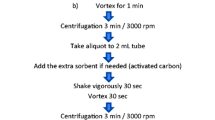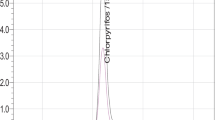Abstract
A modified, efficient, and sensitive acetate-buffered QuEChERS extraction method was developed for the quantitative study of 16 commonly applied multiclass pesticides on date palm fruit. The date palm fruit samples were rehydrated by adding water during comminution. Samples were extracted with acidified acetonitrile, buffered with acetate salt. To minimize the matrix interferences, clean-up of the rehydrated samples was optimized by comparison with different sorbents (alumina, silica gel, florisil, primary secondary amine (PSA), and chitosan). The method validation parameters were evaluated as per European Union (EU) guidelines (SANTE/12682/2019). For 16 pesticides, % recovery of 69 to 121.8% with an associated precision (RSD ≤ 20%) was achieved at the fortification levels that were 0.5 to 2 times of European Union maximum residue limits (EU-MRLs). The validated method was successfully employed for the analysis of date palm fruit samples (n = 20) collected from various markets. Forty percent (40%) of samples (n = 8) were found to be contaminated with various pesticides. The most frequently detected residues were carbofuran, carbaryl, metalaxyl, tebuconazole, triazophos, and pyriproxyfen. The concentration of all the detected pesticides in real samples was below the EU-MRLs.




Similar content being viewed by others

References
Abbassy, M. A., Salim, Y. M. M., Shawir, M. S., & Nassar, A. M. K. (2017). Disappearance and hazard quotient of chlorpyrifos-methyl, fipronil, and imidacloprid insecticides from dates. Journal of Consumer Protection and Food Safety, 12(3), 223–230. https://doi.org/10.1007/s00003-017-1111-3
Abdallah, O. I., Alamer, S. S., & Alrasheed, A. M. (2018). Monitoring pesticide residues in dates marketed in Al-Qassim, Saudi Arabia using a QuEChERS methodology and liquid chromatography–tandem mass spectrometry. Biomedical Chromatography, 32(6), e4199. https://doi.org/10.1002/bmc.4199
Abul-Soad, A. A. (2010). Date palm in Pakistan, current status and prospective. USAID Firms Project, 9–11.
Agricultural Marketing Information Service (AMIS). (2017–18). http://www.amis.pk/files/Fruit%20&%20Vegetable%20Condiments%20of%20Pakistan%202017-18.pdf. Accessed Oct 20th, 2020.
Agricultural Marketing Information Service (AMIS). (2018–19). http://www.amis.pk/Import%20and%20Export%20of%20Agricultural%20Commodities/ImportAndExport.html. Accessed Oct 20th, 2020.
Al-Rehiayani, S., & Osman, K. A. (2005). Fate of preharvest-sprayed dicofol in date fruits: Residue analysis by HPLC-UV. Agricultural and Marine Sciences, 10(1), 21–26.
Anastassiades, M., Ellen, S., Tasdelen, B., & Stajnbaher, D. (2007). Recent developments in QuEChERS methodology for pesticide multiresidue analysis. Pesticide chemistry: Crop protection, public health, environmental safety, 46, 439–458.
Anastassiades, M., Lehotay, S. J., Štajnbaher, D., & Schenck, F. J. (2003). Fast and easy multiresidue method employing acetonitrile extraction/partitioning and dispersive solid-phase extraction for the determination of pesticide residues in produce. Journal of AOAC International, 86(2), 412–431. https://doi.org/10.1093/jaoac/86.2.412
Andraščíková, M., Hrouzková, S., & Cunha, S. C. (2013). Combination of QuEChERS and DLLME for GC-MS determination of pesticide residues in orange samples. Food Additives & Contaminants: Part A, 30(2), 286–297. https://doi.org/10.1080/19440049.2012.736029
Aslam, M., Saeed, A., Pasha, G. R., & Altaf, S. (2010). Gender differences of body mass index in adults of Pakistan: A case study of Multan city. Pakistan Journal of Nutrition, 9(2), 162–166.
BS EN 15662. (2008). Foods of plant origin - Determination of pesticide residues using GC-MS and/or LC-MS/MS following acetonitrile extraction/partitioning and clean-up by dispersive SPE-QuEChERS method.
Christia, C., Bizani, E., Christophoridis, C., & Fytianos, K. (2015). Pesticide residues in fruit samples: Comparison of different QuEChERS methods using liquid chromatography-tandem mass spectrometry. Environmental Science and Pollution Research, 22(17), 13167–13178. https://doi.org/10.1007/s11356-015-4456-0
Commission, Decision 2002/657/EC. (2002). Commission decision of 12 August 2002 implementing Council Directive 96/23/EC concerning the performance of analytical methods and the interpretation of results. Official Journal of the European Communities, 50, 8–36.
Directive 2002/63, EC no. 152. (2009). https://eur-lex.europa.eu/legal-content/EN/TXT/PDF/?uri=CELEX:02009R0152-20170524&from=EN
El-Behissy, E. Y., King, R. D., Ahmed, M. M., & Youssef, A. M. (2001). Fate of postharvest-applied dichlorvos in stored and processed dates. Journal of Agricultural and Food Chemistry, 49(3), 1239–1245. https://doi.org/10.1021/jf000812e
EL-Saeid, M. H., & Al-Dosari, S. A. A. (2010). Monitoring of pesticide residues in Riyadh dates by SFE, MSE, SFC, and GC techniques. Arabian Journal of Chemistry, 3(3), 179–186.
Food and Agriculture Organization (FAO). (2020). http://www.fao.org/faostat/en/#compare
Food and Drug Administration (FDA). (1994). Pesticide analytical manual (3rd ed., p. 1). Department of Health and Human Services, Public Health Service.
Gulzar, A., Hafeez, M., Yousaf, K., Ali, M., Tariq, M., & Tahir, M. N. (2015). Toxicity of some conventional insecticides against mango mealybugs. Drosicha Mangiferae. Science International, 27(2), 1693–1695.
Kujawski, M. W., & Namieśnik, J. (2008). Challenges in preparing honey samples for chromatographic determination of contaminants and trace residues. TrAC Trends in Analytical Chemistry, 27(9), 785–793. https://doi.org/10.1016/j.trac.2008.07.004
Lambropoulou, D. A., & Albanis, T. A. (2007). Methods of sample preparation for determination of pesticide residues in food matrices by chromatography–mass spectrometry-based techniques: A review. Analytical and Bioanalytical Chemistry, 389(6), 1663–1683. https://doi.org/10.1007/s00216-007-1348-2
Lehotay, S. J. (2007). Determination of pesticide residues in foods by acetonitrile extraction and partitioning with magnesium sulfate: collaborative study. Journal of AOAC International, 90, 485–520.
Lehotay, S. J., Son, K. A., Kwon, H., Koesukwiwat, U., Fu, W., Mastovska, K., Hoh, E., & Leepipatpiboon., N. . (2010). Comparison of QuEChERS sample preparation methods for the analysis of pesticide residues in fruits and vegetables. Journal of Chromatography A, 1217(16), 2548–2560. https://doi.org/10.1016/j.chroma.2010.01.044
Łozowicka, B., Mojsak, P., Kaczyński, P., Konecki, R., & Borusiewicz, A. (2017). The fate of spirotetramat and dissipation metabolites in Apiaceae and Brassicaceae leaf-root and soil system under greenhouse conditions estimated by modified QuEChERS/LC–MS/MS. Science of the Total Environment, 603, 178–184. https://doi.org/10.1016/j.scitotenv.2017.06.046
Magnusson, B., Örnemark, U. (2014). The fitness for purpose of analytical methods: A laboratory guide to method validation and related topics. 2nd edition. ISBN 978-91-87461-59-0.
Markhand, G. S., Abul-Soad, A. A., Mirbahar, A. A., & Kanhar, N. A. (2010). Fruit characterization of Pakistani dates. Pakistan Journal of Botany, 42(6), 3715–3722.
Nadeem, M., Rehman, S. U., Anjum, F. M., & Bhatti, I. A. (2011). Quality evaluation of some Pakistani date varieties. Pakistan Journal of Agricultural Sciences, 48(4), 305–313.
Picó, Y., Font, G., Moltó, J. C., & Mañes, J. (2000). Pesticide residue determination in fruit and vegetables by liquid chromatography–mass spectrometry. Journal of Chromatography A, 882(1), 153–173. https://doi.org/10.1016/S0021-9673(00)00294-6
Picó, Y., El-Sheikh, M. A., Alfarhan, A. H., & Barceló, D. (2018). Target vs non-target analysis to determine pesticide residues in fruits from Saudi Arabia and influence in potential risk associated with exposure. Food and Chemical Toxicology, 111, 53–63. https://doi.org/10.1016/j.fct.2017.10.060
Rafique, N., Nazir, S., Akram, S., Ahad, K., Gohar, A., Abbasi, S. T., Ahmed, I., & Rafique, K. (2018). Screening of multiclass pesticide residues in honey by SPE-GC/MSD: A pilot study. Environmental Monitoring and Assessment, 190(11), 666–677. https://doi.org/10.1007/s10661-018-7041-4
Rizzetti, T. M., Kemmerich, M., Martins, M. L., Prestes, O. D., Adaime, M. B., & Zanella, R. (2016). Optimization of a QuEChERS based method by means of central composite design for pesticide multiresidue determination in orange juice by UHPLC–MS/MS. Food Chemistry, 196, 25–33. https://doi.org/10.1016/j.foodchem.2015.09.010
SANTE/12682/2019. (2019). Guidance document on analytical quality control and method validation procedures for pesticides residues analysis in food and feed, EC regulation no. 396/2005, https://eurlex.europa.eu/LexUriServ/LexUriServ.do?uri=CONSLEG:2005R0396:20080410:EN:PDF. Accessed Jan 15th, 2020.
United States Department of Agriculture (USDA). (2018). National nutrient database for standard reference release legacy full report (all nutrients). Accessed Aug 7th, 2020.
Wang, H. S., Sthiannopkao, S., Du, J., Chen, Z. J., Kim, K. W., Salleh, M., Yasin, M., Hashim, J. H., Wong, C. K. C., & Wong, M. H. (2011). Daily intake and human risk assessment of organochlorine pesticides (OCPs) based on Cambodian market basket data. Journal of Hazardous Materials, 192(3), 1441–1449. https://doi.org/10.1016/j.jhazmat.2011.06.062
Wang, J., Chow, W., Leung, D., & Chang, J. (2012). Application of ultrahigh-performance liquid chromatography and electrospray ionization quadrupole orbitrap high-resolution mass spectrometry for determination of 166 pesticides in fruits and vegetables. Journal of Agricultural and Food Chemistry, 60(49), 12088–12104. https://doi.org/10.1021/jf303939s
Zhao, P., Wang, L., Jiang, Y., Zhang, F., & Pan, C. (2012). Dispersive cleanup of acetonitrile extracts of tea samples by mixed multiwalled carbon nanotubes, primary secondary amine, and graphitized carbon black sorbents. Journal of Agricultural and Food Chemistry, 60(16), 4026–4033. https://doi.org/10.1021/jf205351t
Funding
This work was financially supported by Government of Pakistan under the PSDP project (PSDP-714) entitled “National Pesticides Residue Monitoring System in Pakistan (NPRMS).”
Author information
Authors and Affiliations
Contributions
All authors contributed to the study conception and design. Conceptualization: Somia Qayyum and Farrakh Mehboob. Methodology: Somia Qayyum, Touqeer Taj, and Muhammad Tauseef. Data acquisition and analysis: Somia Qayyum, Nazia Rafique, and Muhammad Ishtiaq. Writing—original draft preparation: Somia Qayyum. Writing—review and editing: Somia Qayyum, Farrakh Mehboob, Muhammad A. Mirza, and Muhammad A. Choudhary. Supervision: Karam Ahad and Farrakh Mehboob.
Corresponding author
Ethics declarations
Ethics approval
This article does not contain any studies with human participants or animals performed by any of the authors.
Consent to participate
Informed consent is not applicable to the nature of this study.
Conflict of interest
The authors declare no competing interests.
This manuscript has not been published and is not under consideration for publication elsewhere.
Additional information
Publisher's Note
Springer Nature remains neutral with regard to jurisdictional claims in published maps and institutional affiliations.
Rights and permissions
About this article
Cite this article
Qayyum, S., Taj, T., Tauseef, M. et al. Determination of pesticide residues in dates using UHPLC-QqQ-MS/MS: method development and validation. Environ Monit Assess 193, 613 (2021). https://doi.org/10.1007/s10661-021-09361-y
Received:
Accepted:
Published:
DOI: https://doi.org/10.1007/s10661-021-09361-y



